Over the last few months the
J. P. Morgan Library in
New York mounted three shows, each of which was worth the price of admission. Rather than a long disquisition I'll offer some brief thoughts on each, along with pictures, to give a sense of why I was glad to have caught them.

First, the Library memorialized the 100th anniversary of the publication of
Marcel Proust's (1871-1922)
Du côté de chez Swann (1913)
, better known in English as
Swann's Way, the first volume in what would be come one of the masterworks of the 20th century, and of all literature,
À la recherche du temps perdu (
In Search of Lost Time), with an exhibit on the background of the novel, Proust, and a trove of manuscripts, including letters he wrote to his beloved mother, the notebooks in which he took down thoughts towards
Swann's Way, the handwritten manuscript drafts, and the bound, marked-up galley pages.
Though I was quite familiar with Proust's life and story, it was something altogether new to be able to view his handwriting, to note how he was unfolding his ideas on the page, and to study how he edited the opening of
Swann's Way, crossing out a large swath of meandering prose and inserting in its place that unforgettable opening, "Longtemps je me suis couché de bonne heure." (For a long time I would go to bed early"), which in its rhythmic propulsion, idiomatic playfulness and grace, and narrative foreshadowing portends not just the rest of the first section but the entire giant work. The musical title itself, something I'd always wondered about, turns out to have been a bit of slang Proust was playing with; it literally means "Alongside Swann's home," which sounds awful for an English title, and was also controversial among French grammarians. What the exhibit also shows is that
Swann's Way, initially rejected by nearly all the major Parisian publishing houses, was so long that the ultimate publisher,
Grasset, who required Proust to subsidize its production (yes, this began as a vanity project!), demanded that the author lop off a sizable chunk from the novel's end, and, because Proust wanted the book to appear, he complied. The second volume,
À l'ombre des jeunes filles en fleurs (
In the Shadow of Young Girls In Flower, a/k/a
In a Budding Grove) did not appear until the end of the
First World War, in 1919. Despite the rejection Proust encountered at first, the estimation by many in Paris's literary world that he was a wealthy dilettante and socialite, and Grasset's own rather harsh editorial treatment of his work, there were admirers who immediately grasped his brilliance; the exhibit names two American literary masters who read him upon the book's publication in the original French:
Edith Wharton, who knew she was in the hands of one of the all-time greats, and
Henry James, to whom she sent
Swann's Way, who also perceptively lauded Proust's genius. The seeds of that genius, cultivated and nurtured, are visible in this show.
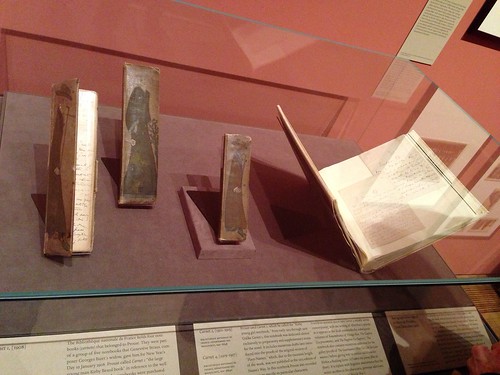 |
Proust's notebooks (note the illustrations on the covers
of these narrow, pocket-perfect volumes) |
 |
Proust's notebooks containing notes and
drafts of what would become Swann's Way |
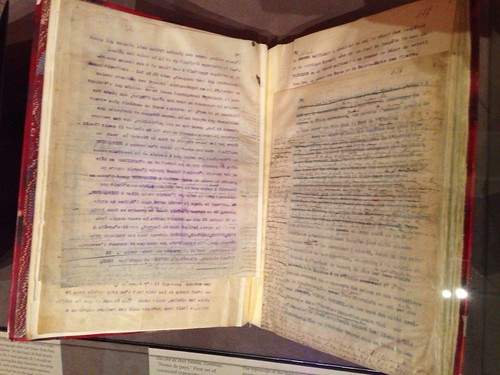 |
The typescript version of Swann's Way
with Proust's annotations and changes |
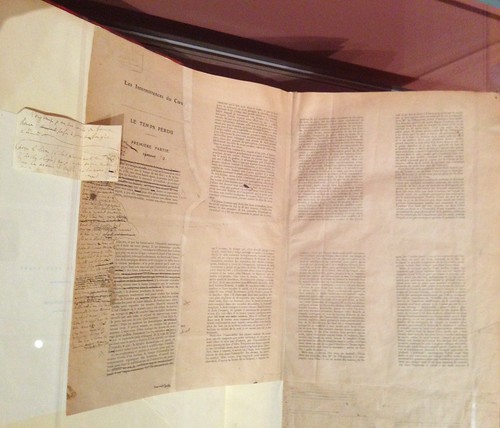 |
The third galley (incomplete) of Swann's Way
on which Proust has inserted, on a piece of paper,
his famous opening line, "Longtemps je me
suis couché de bonne heure...." |
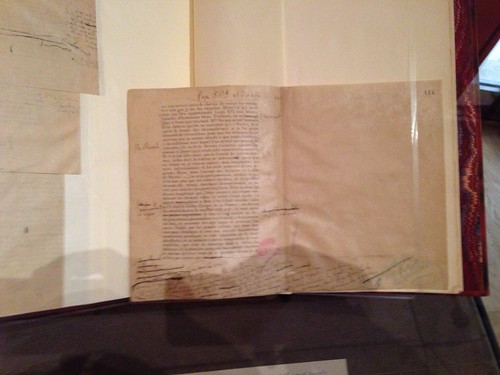 |
Proust's galley, with the truncation
Grasset required, concluding Swann's Way |
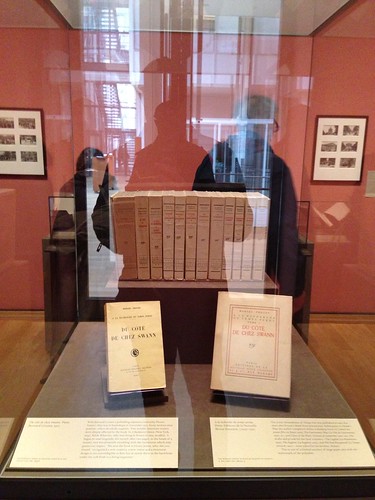 |
In Search of Lost Time (the complete,
multivolume text) |
***
 |
| Miss La La (Anna "Olga" Brown) |
There also was an enthralling exhibit focusing on French artist
Edgar Degas's (1834-1917) drawings and eventual 1879 painting of the famous 19th century black aerialist,
Miss La La (Anna Olga Albertina Brown) (b. 1858-1919?), at the
Cirque Fernando, one of the popular mass entertainment venues in mid-century
Paris. Yes, you read that right; Miss La La was an acrobat, born to a black father and a white Prussian mother, who performed with the
Troupe Kaira and regularly transfixed Paris and other cities in Europe. Degas's painting, considered one of his masterpieces, required his usual intense preparation, but with even greater concentration, for while he was able to render Miss La La, suspended high above the circus floor by dint of her bite on a suspended from a rope, fairly easily, he struggled to capture the geometry of the circus building's ceiling and rafters.
According to the exhibit, Degas may even have had some help with the drafting of the arches and planes, though it is known that he studied the architectural plans quite carefully. The preparatory drawings, pastels, and paintings of Miss La La on display all offered their own considerable beauty, and it was thrilling to move along the wall and note how Degas was working up towards the extraordinary painting, "Miss La La at the Cirque Fernando" (oil on canvas, 1879, National Gallery, UK), that resulted, though interestingly, Miss La La's racial identity is less evident in the final work than in the preparatory ones. What one notices in that final image is her floating form, inspired in part by religious iconography Degas was quite familiar with, as well as other circus images by peers, and that almost glowing, orange vault of ceiling and the arches and pillars holding them up, as carefully poised as the aerialist herself.
The exhibit did not say what happened to her, though
Reggie H.
sent a link with more information on her (can't find it on
Wikipedia!), including that she was born in Stettin, formerly in the Prussian Empire and now part of Poland (Szczecin), and that was known various as Olga Kaira, Olga Kaire,
la Venus Noire, “Olga the Mulatto”, “Olga the Negress”, “The Venus of the Tropics”, “The Cannon Woman” and “The African Princess.” According the
Circus Girl blogsite, she continued performing up to the late 1880s, married an American contortionist named Emmanuel (Manuel) Woodson, and had a daughter named Rose Eddie Woodson, who was born in London in 1894, before giving birth to two more daughters who together became an act known as the "Three Keziahs." Apparently the last known recorded year of Olga's life was 1919, when she was listed on a US passport application. Had I the time I'd spend a bit of it trying to learn what happened to her. Degas, who had mixed-raced relatives on his mother's side, not only painted one of his greatest works when capturing her, but immortalized this extraordinary figure.
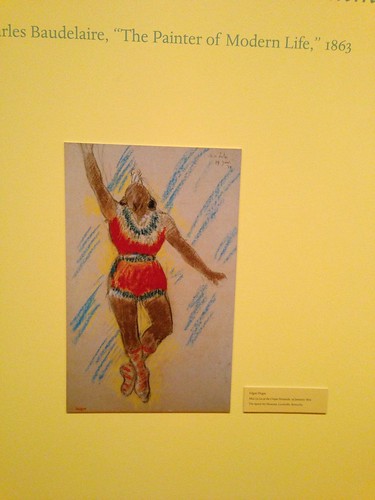 |
| A reproduction of a Degas pastel |
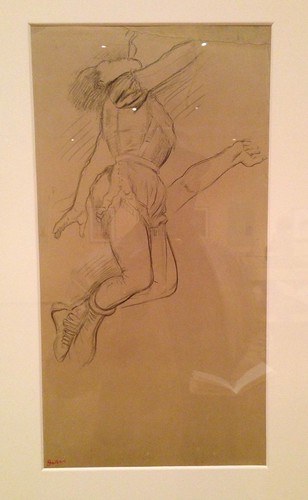 |
| A preparatory sketch (charcoal on brown paper), 1879 |
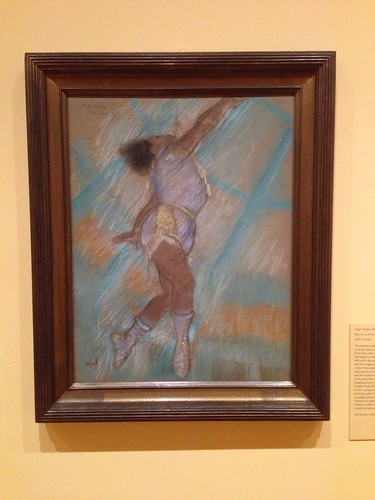 |
A preparatory pastel, on brown paper
(one of the most "Impressionistic" of
all his versions here) |
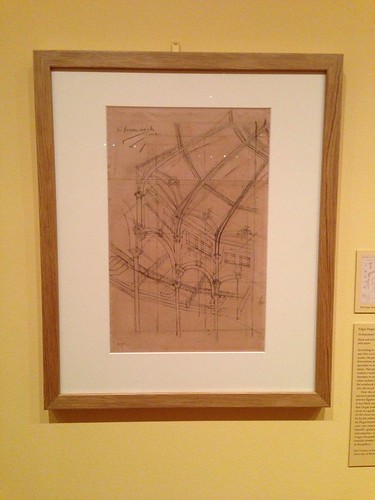 |
Degas' draft of the architecture
in the Cirque Fernando's ceiling |
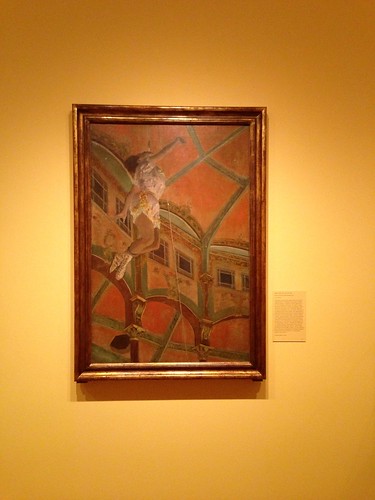 |
Edgar Degas, Miss La La at the Cirque Fernando
(oil on canvas, 1879) |
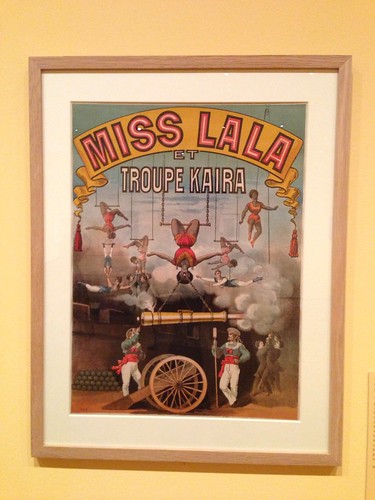 |
A poster featuring the Troupe Kaira
and highlighting Miss La La |
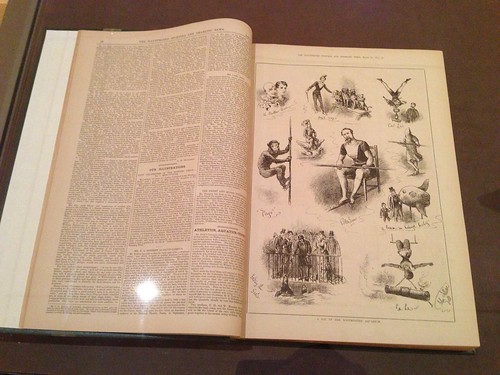 |
An illustrated magazine, featuring
images of circus participants,
including Miss La La on the lower right |
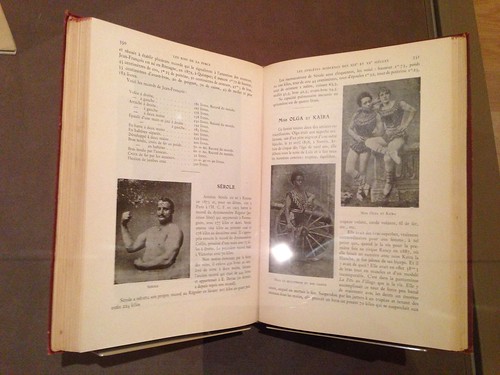 |
A book that includes a discussion
of Olga (Miss La La) and her acrobatic
partner, Kaira la Blanche (Theophila Szterker) |
***
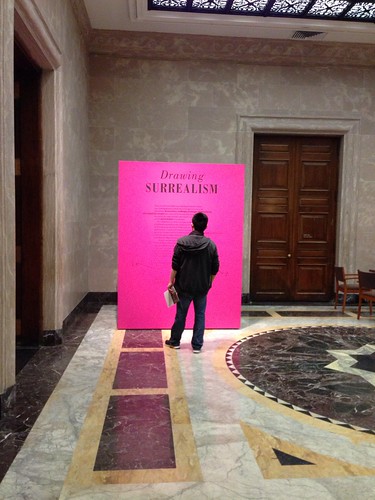
These two exhibits would have been enough for any museum visit, but there was also the
Drawing Surrealism show to explore. A surfeit of energizing, deranging riches, filling two large galleries. Ego yes, but so much
id! In fact it contained 165 works by 70 artists from 15 countries on paper, including many of the most famous Surrealist stars, like
René Magritte, Giorgio DiChirico, Salvador Dalí, and
Jean Arp, as well as some I did not expect, like
Georges Bataille. Artists preceding or following the Surrealists, like
Frida Kahlo also make appearances, and throughout the show gently guides you along the pathways of affiliation and influence. One highlight and delight was a painting by
Wilfredo Lam, Surrealism's man in
Cuba. There also were more recent non-Euro-American artists working in that tradition, which was a refreshing addition.
The show unfolds by emphasizing Surrealist techniques, including collage, automatic drawing, decalcomania, frottage, and some of the most striking imagery of all produced through the
exquisite corpse method. Viewing this group of images made me want to gather up a group of friends, have a few drinks, and produce a few exquisite corpse drawings and texts for fun. (I just might have to do that.) A number of the works had this effect, though, which in a sense is in keeping with the Surrealist ethos. Unfortunately this show ended on April 21, so if you pass through New York you can still catch the Proust and Degas exhibits, but these Surrealist renderings won't be departing my memory anytime soon. Should someone mount a future show featuring these artists and works, perhaps pairing a bit of the poetic and prose works, music, and other artistic forms that also constituted Surrealism would make for quite a event. A participatory
exquisite corpse dramatic or performance work wouldn't be a bad idea either.
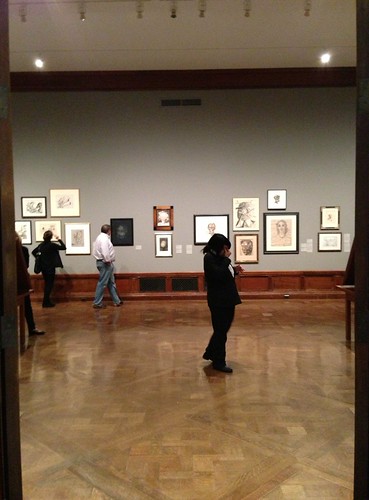 |
| One of the Drawing Surrealism exhibit rooms |
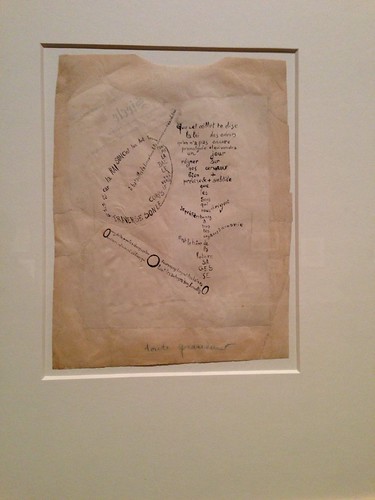 |
Guillaume Apollinaire, "La mandoline,
l'oeillet et la bambeau" (1915-1917) |
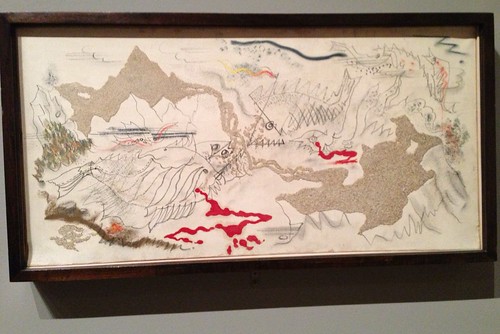 |
André Masson, Battle of Fishes (1926)
(he uses sand on the painting, as you can see) |
 |
| Wilfredo Lam, "Woman and Bird" (1942) |
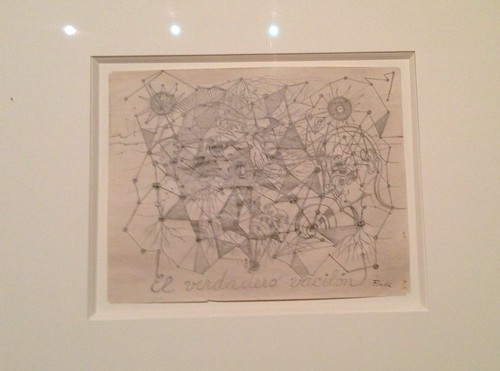 |
| Frida Kahlo, "El verdadero vacilón" (1946-47) |
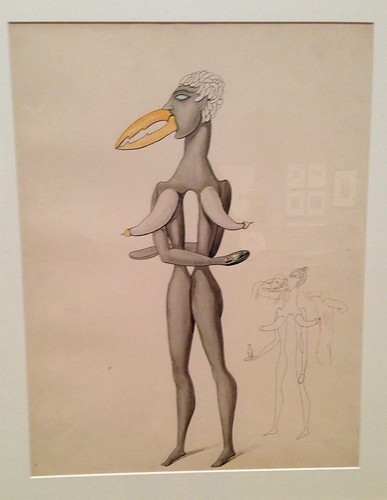 |
| Victor Brauner, "L'Anatomie du désir" (1933) |
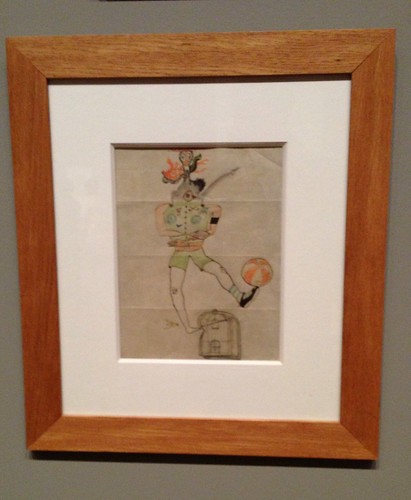 |
Exquisite corpse drawing (collaboratively
created by André Breton, Marcel Duhamel,
Max Morise, and Yves Tanguy, 1928) |
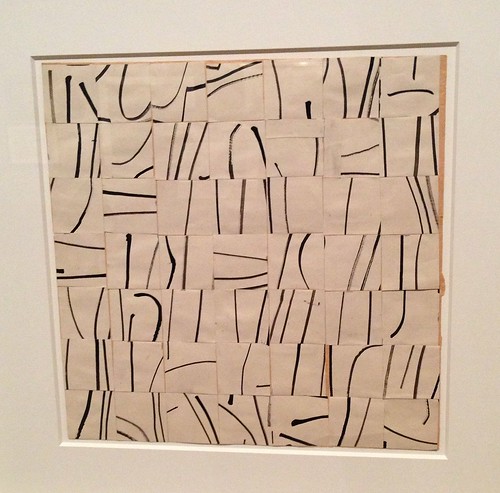 |
Ellsworth Kelly, "Brushstrokes Cut into 44 Squares
and Arranged by Chance," 1951 |
 First, the Library memorialized the 100th anniversary of the publication of Marcel Proust's (1871-1922) Du côté de chez Swann (1913), better known in English as Swann's Way, the first volume in what would be come one of the masterworks of the 20th century, and of all literature, À la recherche du temps perdu (In Search of Lost Time), with an exhibit on the background of the novel, Proust, and a trove of manuscripts, including letters he wrote to his beloved mother, the notebooks in which he took down thoughts towards Swann's Way, the handwritten manuscript drafts, and the bound, marked-up galley pages.
First, the Library memorialized the 100th anniversary of the publication of Marcel Proust's (1871-1922) Du côté de chez Swann (1913), better known in English as Swann's Way, the first volume in what would be come one of the masterworks of the 20th century, and of all literature, À la recherche du temps perdu (In Search of Lost Time), with an exhibit on the background of the novel, Proust, and a trove of manuscripts, including letters he wrote to his beloved mother, the notebooks in which he took down thoughts towards Swann's Way, the handwritten manuscript drafts, and the bound, marked-up galley pages. These two exhibits would have been enough for any museum visit, but there was also the Drawing Surrealism show to explore. A surfeit of energizing, deranging riches, filling two large galleries. Ego yes, but so much id! In fact it contained 165 works by 70 artists from 15 countries on paper, including many of the most famous Surrealist stars, like René Magritte, Giorgio DiChirico, Salvador Dalí, and Jean Arp, as well as some I did not expect, like Georges Bataille. Artists preceding or following the Surrealists, like Frida Kahlo also make appearances, and throughout the show gently guides you along the pathways of affiliation and influence. One highlight and delight was a painting by Wilfredo Lam, Surrealism's man in Cuba. There also were more recent non-Euro-American artists working in that tradition, which was a refreshing addition.
These two exhibits would have been enough for any museum visit, but there was also the Drawing Surrealism show to explore. A surfeit of energizing, deranging riches, filling two large galleries. Ego yes, but so much id! In fact it contained 165 works by 70 artists from 15 countries on paper, including many of the most famous Surrealist stars, like René Magritte, Giorgio DiChirico, Salvador Dalí, and Jean Arp, as well as some I did not expect, like Georges Bataille. Artists preceding or following the Surrealists, like Frida Kahlo also make appearances, and throughout the show gently guides you along the pathways of affiliation and influence. One highlight and delight was a painting by Wilfredo Lam, Surrealism's man in Cuba. There also were more recent non-Euro-American artists working in that tradition, which was a refreshing addition. First, the Library memorialized the 100th anniversary of the publication of Marcel Proust's (1871-1922) Du côté de chez Swann (1913), better known in English as Swann's Way, the first volume in what would be come one of the masterworks of the 20th century, and of all literature, À la recherche du temps perdu (In Search of Lost Time), with an exhibit on the background of the novel, Proust, and a trove of manuscripts, including letters he wrote to his beloved mother, the notebooks in which he took down thoughts towards Swann's Way, the handwritten manuscript drafts, and the bound, marked-up galley pages.
First, the Library memorialized the 100th anniversary of the publication of Marcel Proust's (1871-1922) Du côté de chez Swann (1913), better known in English as Swann's Way, the first volume in what would be come one of the masterworks of the 20th century, and of all literature, À la recherche du temps perdu (In Search of Lost Time), with an exhibit on the background of the novel, Proust, and a trove of manuscripts, including letters he wrote to his beloved mother, the notebooks in which he took down thoughts towards Swann's Way, the handwritten manuscript drafts, and the bound, marked-up galley pages.














 These two exhibits would have been enough for any museum visit, but there was also the Drawing Surrealism show to explore. A surfeit of energizing, deranging riches, filling two large galleries. Ego yes, but so much id! In fact it contained 165 works by 70 artists from 15 countries on paper, including many of the most famous Surrealist stars, like René Magritte, Giorgio DiChirico, Salvador Dalí, and Jean Arp, as well as some I did not expect, like Georges Bataille. Artists preceding or following the Surrealists, like Frida Kahlo also make appearances, and throughout the show gently guides you along the pathways of affiliation and influence. One highlight and delight was a painting by Wilfredo Lam, Surrealism's man in Cuba. There also were more recent non-Euro-American artists working in that tradition, which was a refreshing addition.
These two exhibits would have been enough for any museum visit, but there was also the Drawing Surrealism show to explore. A surfeit of energizing, deranging riches, filling two large galleries. Ego yes, but so much id! In fact it contained 165 works by 70 artists from 15 countries on paper, including many of the most famous Surrealist stars, like René Magritte, Giorgio DiChirico, Salvador Dalí, and Jean Arp, as well as some I did not expect, like Georges Bataille. Artists preceding or following the Surrealists, like Frida Kahlo also make appearances, and throughout the show gently guides you along the pathways of affiliation and influence. One highlight and delight was a painting by Wilfredo Lam, Surrealism's man in Cuba. There also were more recent non-Euro-American artists working in that tradition, which was a refreshing addition.
















No comments:
Post a Comment